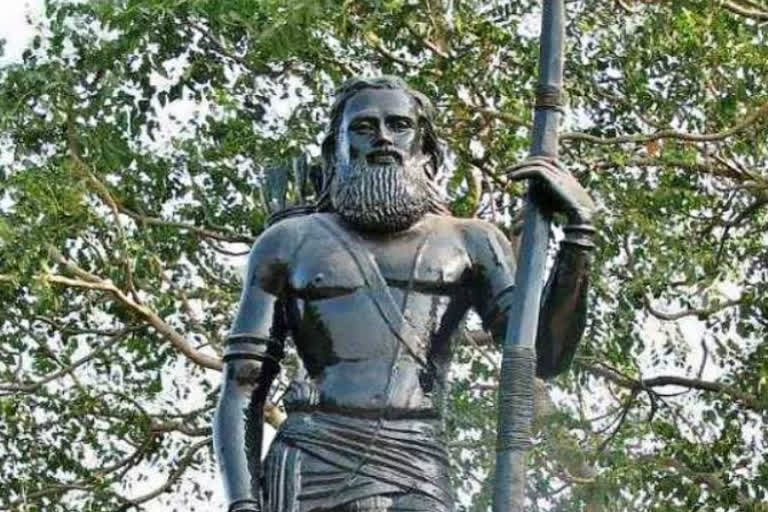Hyderabad: The legendary revolutionary was surrounded by hundreds of British soldiers with mounted guns and loaded cannons, but he didn't fear any of them, rather he looked fearless. Finally, the bullets hit him and the blood oozed out of his body, still, he showed his chest, saying ''shoot here''. Truly, a heroic end to Alluri Sitarama Raju who send shivers down the spine of Britishers until his death.
The 27-year-old left behind four bows and a legacy as well. At the peak of fighting, he stormed the British walls and blew up police stations like firecrackers. Alluri Sitaramaraju is that revolutionary arrow that struck fear in the hearts of the enemy and inspired generations of patriots.
The year 1922, 22 August, Visakha Forest Area, Chintapalli Police Station. Sudden heart-rending shouts shattered the otherwise usual silence. Around 300 people ambushed the police station and tore records. Guns and ammunition were taken away, not like a thief, but like a noble warrior. What was being taken away was marked in the record book and signed by a person. His name was Alluri Sitaramaraju who gave some sleepless nights to Britishers.
Also Read: PM Modi to unveil 30 feet bronze statue of Alluri Sitaramaraj in Bhimavaram
Under British rule, police stations were centers of anarchy. They suppressed the voices that were raised for their rights with iron fists. In fact, people dreaded watching a police station even from a distance. Hence, Raju's attack on a police station proved to be a wake-up call to ruthless Britishers. Yet again, the legendary Alluri army took British police by surprise on August 23, 1922, after they attacked Krishnadevipeta, and Raja Ommangi police stations and took away arms and ammunition, throwing up a challenge of sorts to the ruling dispensation.
The British government was devasted after three back-to-back attacks on its police forces. Invariably, to crush the revolution, it sent officers named Kabardu and Haiter to Chintapalli. On September 24, 1922, Kabardu and Haiter went into the forest with the army only to be defeated by Rama Raju's army. The British were even more enraged and resented Alluri. But this ''Giriputra'' (son of the hills) was not scared. The invasion of police stations continued.
This time he adopted guerilla warfare and challenged the British during his attack on the Addatigala police station. Raju carried out the attack on October 15. The British army had no option but to surrender. Also, Rama Raju besieged Rampachodavaram station in broad daylight on October 19 with the same zeal. Sitarama Raju used police stations to store weapons and saved people from police harassment.
Born on July 4, 1897, in Pandrangi, Visakha district, Alluri was educated in Kovwada, Narsapuram, Ramachandrapuram, and Tuni in Godavari districts. He discontinued schooling claiming that a teacher has beaten him for failing in the fourth form. Later, he espoused the cause of the tribals after seeing their plight. In between, he went on a trip to North India and became a Yogi.
He returned to the Visakha agency and practised yoga near Krishnadevipeta where the Tandava river meets 'Chikkalagadda'. The Alluri Yogamudra was disturbed by the anarchist British. Alluri couldn't bear the atrocities meted out to the children of the agency area, such as stopping illegal agriculture and putting restrictions on the sale of forest products along with atrocities like rapes and harassment.
In August 1922, Alluri turned into a warrior and rallied the tribals and gave them bows and arrows. In fact, Rama Raju transformed 150 common people into well-trained revolutionary heroes. He rose to dizzy heights. On December 6, 1922, the government troops opened fire on the Alluri army and four of his followers were martyred while eight other revolutionaries were killed in the late-night raid. This was the first blow to tribal warriors. Later, Britishers announced a bounty on Rama Raju and his followers.
On April 17, 1923, Sitaramaraj appeared at Annavaram along with his followers and surprised the British. The then collector was furious that the people looked upon Ramaraju as a demi-god. He imposed an additional tax on the people as a fine but the people didn't give up Alluri.
The police eventually cordoned off the entire agency area to quell the revolution. People were deprived of food. Young and old were killed. On 17 April 1924, Rutherford arrived as Special Commissioner for the Agency area, held a meeting in Krishnadevipeta, and warned people that they would be killed if they don't disclose the whereabouts of the revolutionaries within a week.
Rama Raju decided to surrender since the pressure of the British army was affecting his people. On May 7, 1924, a cowherd sitting at a farm near Koiyur informed the police about the fighter's whereabouts. Then, Ramaraju was surrounded by the police, caught and tied to a tree near Major Goodall. Ramaraju was shot dead without any trial. There was a twinkle in the eyes of the Britishers, but there was no tremor in Alluri's back. Even as bullets were raining on him, Ramaraju chanted Vande Mataram. On May 8, Alluri's body was cremated and a memorial was built in Krishnadevipeta.
The revolutionary struggle of Agency hero started on 22 August 1922 and ended in the first week of July 1924. The great warrior died at the age of 27. National newspapers hailed Alluri as Shivaji, Rana Pratap, and Lenin. Gandhiji, who led the non-violent movement, also glorified Alluri as a hero in Young India magazine in 1926. Azad Hind Fauz founder Subhash Chandra Bose also praised Alluri and said Indians cannot forget 'such great heroes.



